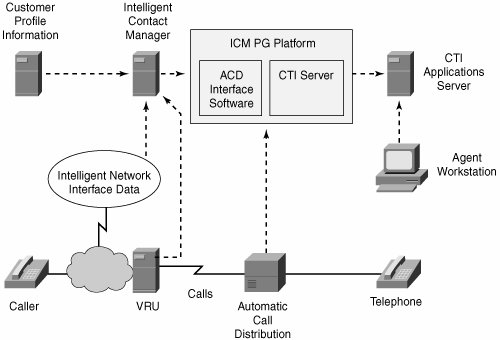Contact Centers
| Contact centers are the hubs of the customer service efforts of many growing businesses. Forward-thinking companies are integrating this key function with Internet technology to transform customer care into a powerful business-building force. Firms such as catalog sellers, telemarketers, and computer helpdesks use traditional contact centers to manage large volumes of telephone calls and customer contacts. Contact center applications route incoming calls to sales and service agents who can respond to customer needs. Integrating this contact center activity with an Internet-based customer-relationship management (CRM) solution gives agents immediate access to customer purchase histories, order tracking capabilities, and other key information and tools. This enhanced information flow enables contact center staff to use customer interaction to build customer loyalty and retention. Traditional contact center technology, as illustrated in Figure B-10, recognizes incoming contact requests (for example, calls, e-mails, faxes, and web requests) and routes them to available agents. These contact center technologies include recognition of customer telephone numbers, account numbers, or IDs. Customer data appears on the agent computer screen, ensuring that the agent can access the customer orders, account balance, and other crucial data. However, real-time collaboration between the customer and the agent is limited to the spoken word. Services and product offerings are limited to verbal description, usually a script read by the agent. Figure B-10. Contact Center Technology Cisco IP Contact Center (IPCC) with Internet access allows contact center agents to respond to customer queries over a variety of channels, such as telephone, e-mail, web, and fax. As an example, consider a situation where a customer calls a contact center with questions about a new product and an agent can immediately send an e-mail message that includes product specifications and a link to a downloadable interactive demo. This scenario allows customer-service agents to take on sales and marketing roles, which helps the company roll out new initiatives and promotions quickly to targeted customers. Other ways to enhance real-time customer collaboration include fax-back services and web-page collaboration, where the customer and agent interact on the same web page to ensure, for example, that the color of a sweater is correct. Contact centers use a range of telephone, computer, and network technologies, including VoIP. In Figure B-10, Cisco Intelligent Call Management (ICM) software is at the heart of the contact center application. The ICM uses CTI technology to deliver caller account information to the agent desktop while the agent receives the VoIP call. The location independence of the agents adds another benefit to this model. "Follow-the-sun" customer support programs allow around-the-clock customer service, regardless of the agent location. |
EAN: 2147483647
Pages: 111